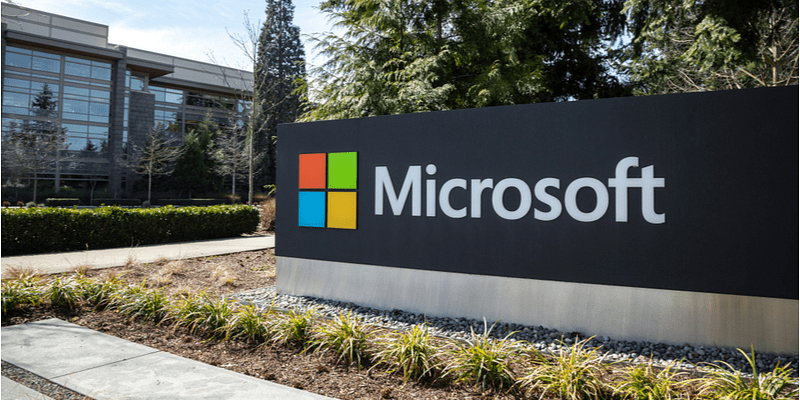
surpassed expectations with its Q4 financial results for the quarter ended June 30, 2023, reporting better-than-expected top and bottom-line figures. Despite this, its shares experienced a decline as Azure cloud revenue growth showed signs of slowing.
The company’s net profit in the quarter was $20.1 billion, up 20% as compared to the corresponding period of the last fiscal year. Its fourth-quarter revenue increased 8% to $56.2 billion from $51.3 billion in the year-ago period.
The software giant concluded FY23 with a revenue of $211.9 billion, representing a 7% year-over-year increase, and a net profit of $72.4 billion, slightly below the previous fiscal year.
Microsoft is the second-largest player in the cloud computing space, followed by . In Q4, revenue growth from Azure and other cloud services was 26% compared with 27% in the previous quarter.
“In Azure, we expect revenue growth to be 25% to 26% in constant currency, including roughly two points from all Azure AI Services,” Amy Hood, Executive Vice President and Chief Financial Officer of Microsoft, said during the earnings call.
Since Q3 2022, Azure growth has seen a sequential decline in every quarter. However, Microsoft’s cloud revenue in the quarter was $30.3 billion, up 21% year-over-year. , which competes with the duo in the cloud computing space, witnessed growth in cloud business in its last quarter.
“Organisations are asking not only how–but how fast they can apply this next generation of AI to address the biggest opportunities and challenges they face– safely and responsibly,” said Microsoft Chairman and Chief Executive Officer Satya Nadella. “We remain focused on leading the new AI platform shift, helping customers use the Microsoft Cloud to get the most value out of their digital spend, and driving operating leverage.”
.thumbnailWrapper
width:6.62rem !important;
.alsoReadTitleImage
min-width: 81px !important;
min-height: 81px !important;
.alsoReadMainTitleText
font-size: 14px !important;
line-height: 20px !important;
.alsoReadHeadText
font-size: 24px !important;
line-height: 20px !important;

<figure class="image embed" contenteditable="false" data-id="521988" data-url="https://images.yourstory.com/cs/2/e641e900925711e9926177f451727da9/Imagea63q-1624592393556.jpg" data-alt="Windows" data-caption="
” align=”center”>

The Redmond-headquartered firm broadly categorises its revenue under three segments—Productivity and Business Processes, Intelligent Cloud, and More Personal Computing. Revenue in Productivity and Business Processes was $18.3 billion in the quarter, up 10% year-over-year.
Revenue from Intelligent Cloud, which includes the Azure cloud computing platform, rose by 15% to reach $24 billion in the June-ended quarter.
More Personal Computing—which includes revenues from Windows OEM, Devices, Xbox content and services, Search and news advertising, as well as Windows Commercial products and cloud services—was down 4% to $13.9 billion in the quarter.
In the reported period, Windows revenue declined by 5%, mainly due to a decrease in Windows OEM revenue, which saw a 12% decrease primarily driven by the ongoing weakness in the PC market. Additionally, its devices revenue also declined by 20%.
According to a report by market analyst firm Canalys, the worldwide PC market declined in the June-ended quarter, with total shipments of desktops and notebooks down 11.5% year on year to 62.1 million units.
Microsoft’s business and employment-oriented online service LinkedIn’s revenue increased 5% driven by growth in talent solutions.
Gaming remains a primary focus for Microsoft, and the company has achieved significant advancements in this area over the past few years, such as introducing next-generation consoles, cloud gaming, and its proposed acquisition of Activision Blizzard, the maker of ‘Call of Duty’, valued at $68.7 billion.
According to Hood, Microsoft is actively working to finalise the deal, pending regulatory approvals. It would be Microsoft’s largest-ever and the biggest gaming industry deal.
Speaking about the outlook for the next fiscal, Hood said, “The impact in H1 is expected to be greater than H2. At a total company level, revenue growth from our commercial business will continue to be driven by the Microsoft Cloud.”
“To support our Microsoft Cloud growth and demand for our AI platform, we will accelerate investment in our cloud infrastructure. We expect capital expenditures to increase sequentially each quarter through the year as we scale to meet demand signals,” she added.
Edited by Affirunisa Kankudti










